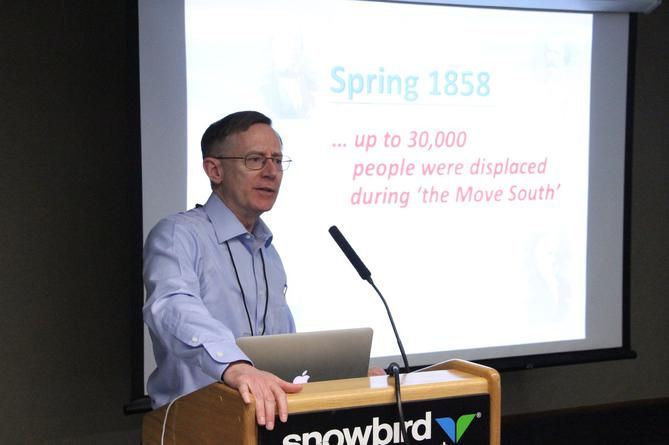Mormon History Association Conference: Journal entries share experiences of women during 'Mormon
- R. Scott Lloyd
- Jun 23, 2016
- 3 min read

The following article by R. Scott Lloyd appeared in the 23 June 2016 online edition of Deseret News.
SNOWBIRD, UTAH
Characterized by a New York Times editorial of June 17, 1858, as “a mass of blunders from beginning to end,” the “Mormon War” of 1857-58 brought hardship to the Latter-day Saints of northern Utah territory, who were instructed by President Brigham Young to undertake a massive relocation in advance of what they perceived as an invasion by the U.S. Army.
That was a subject of a presentation June 11 by Kenneth L. Alford, professor of Church history and doctrine at Brigham Young University, at the annual Mormon History Association Conference.
“In the spring of 1858, 30,000 people displaced themselves of their own free will … from northern Utah into central and southern Utah,” said Brother Alford, a U.S. Army colonel who retired in 2008 after 30 years on active duty. “That story has been told a little. The story that has not been told is the role that women played and women’s experiences enduring that event.”
Brother Alford said research at the Church History Library and archives at BYU, University of Utah and Utah State University “has found a wealth of women’s diaries and journals from this period. So what I want to do is share some of that with you.”
Brother Alford summarized the events of the period: In the spring of 1857, unfavorable reports were reaching U.S. President James Buchanan about the Utah settlers allegedly being in rebellion against federally appointed officials.
“In May, he issues a presidential order … telling the army to march on Utah and to take the new governor, [Alfred] Cumming, with them,” Brother Alford recounted.
This “expeditionary force” as it was called, amounted to 2,500 soldiers, about a third of the entire national army.
On July 24, 1857, at the celebration of Pioneer Day in Utah, word reached President Brigham Young that the army was coming.
Rather than submit to what they expected would be unjust military rule, the Latter-day Saints sustained President Young in what has come to be known as “the move south.” From as far north as Cache Valley, Utah, and present-day southern Idaho, to as far south as Salt Lake Valley’s Point of the Mountain, the settlers moved en masse with the majority settling temporarily in the Provo area down to present-day Salem, or the Spanish Fork area, Brother Alford said.
Some settlers were left in the settlements with instructions to burn the structures rather than allow the army to take possession of them.
Eventually, peace negotiations were effected, the army marched peaceably through a largely deserted Salt Lake City and established Camp Floyd to the west, and Cumming was installed as territorial governor. But the massive move for three months obliged the Latter-day Saints to make do as best they could in the wilderness.
Elder Wilford Woodruff, who would eventually be the fourth president of the Church, recorded that the main road from Box Elder County to Provo was lined for 100 miles with horses, mules, ox teams, and loose cattle, sheep and hogs as well as men, women and children.
Here are a few of the quotations Brother Alford shared from Mormon pioneer women regarding this experience.
Ann Howell Burt, Welsh convert: “An army is coming to destroy us, so they say. [Johnston’s] army, they call it. They have winter quartered out at ham’s Fork. It may be their intention to destroy us but Providence is over all. I have not fear, yet I know that many are trembling. It looks dark. President Young has counseled the people to move south and we are all going. We have been packing up our few belongings; we haven’t much, which is a consolation at this time.”
Link to Article: http://www.deseretnews.com/article/865656777/Mormon-History-Association-Conference-Journal-entries-share-experiences-of-women-during-Mormon.html?pg=all






Comments